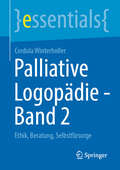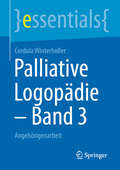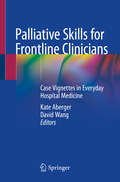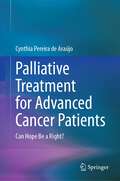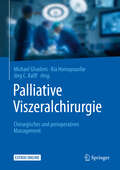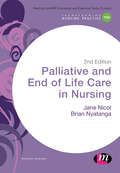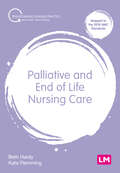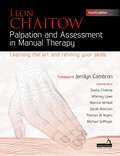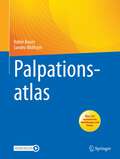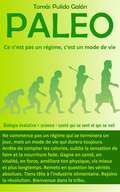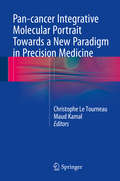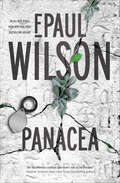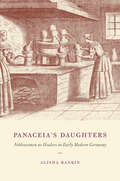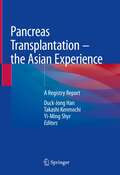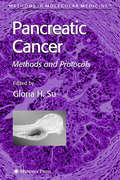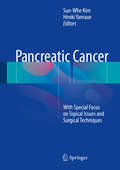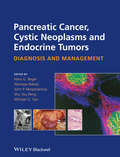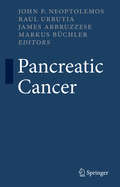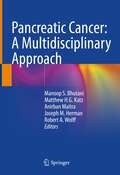- Table View
- List View
Palliative Logopädie - Band 2: Ethik, Beratung, Selbstfürsorge (essentials)
by Cordula WinterhollerDie Logopädie als therapeutischer Baustein findet nur langsam ihren Platz im interdisziplinären Team des Palliative Care Settings. Dabei gehört zu den Aufgaben von Logopäd*innen und Sprachtherapeut*innen auch die Versorgung von schwerstkranken und sterbenden Menschen auf der Palliativstation, im Hospiz oder zu Hause. Bei neuro-palliativen Patienten stehen dabei die Behandlung von Schluck-, Sprach-, Sprech- und Stimmstörungen im Fokus. Die Förderung von Ressourcen in der Kommunikation, beim Essen und Trinken und der Atmung sind für Betroffene von großer Bedeutung. Umso wichtiger ist es, Betroffene und Angehörige fundiert zu beraten und zu begleiten. Ethische Überlegungen fordern Therapeut*innen dabei heraus.In Band 1 erfahren Sie, welche Zielsetzungen, Maßnahmen und Methoden der Bereich der palliativen Logopädie als neuer Fachbereich innerhalb der Logopädie einnehmen kann. Dieser Band 2 legt den Schwerpunkt auf Ethik, Beratung und Selbstfürsorge, Band 3 auf eine praxisnahe Angehörigenberatung.
Palliative Logopädie – Band 3: Angehörigenarbeit (essentials)
by Cordula WinterhollerDie Logopädie als therapeutischer Baustein findet nur langsam ihren Platz im interdisziplinären Team des Palliative Care Settings. Dabei gehört zu den Aufgaben von Logopäd*innen und Sprachtherapeut*innen auch die Versorgung von schwerstkranken und sterbenden Menschen auf der Palliativstation, im Hospiz oder zu Hause. Bei neuro-palliativen Patienten stehen dabei die Behandlung von Schluck-, Sprach-, Sprech- und Stimmstörungen im Fokus. Dieser Band 3 der dreibändigen Reihe geht auf das Umfeld von Angehörigen und deren gezielten und professionellen Unterstützung ein. Sie lernen Instrumente für das Erkennen von Belastungsfaktoren kennen, wie Umfeldanalyse, Belastungswaage und SUD-Skala und können so gezielt auf eine Entlastung reagieren. In Band 1 erfahren Sie, welche Zielsetzungen, Maßnahmen und Methoden der Bereich der palliativen Logopädie als neuer Fachbereich innerhalb der Logopädie einnehmen kann. Band 2 legt den Schwerpunkt auf Ethik, Beratung und Selbstfürsorge.
Palliative Skills for Frontline Clinicians: Case Vignettes in Everyday Hospital Medicine
by David Wang Kate AbergerRooted in everyday hospital medicine, Palliative Skills for Frontline Clinicians addresses the challenges of delivering complex care to patients living with serious illnesses. Spanning emergency medicine, internal medicine, surgery and various subspecialties, each chapter reads like a story, comparing usual care with a step-by-step palliative-based approach. This case-based book features a multidisciplinary, palliative-trained authorship, including neurologists, nephrologists, emergency physicians, surgeons, intensivists, and obstetricians. Divided into four parts, Palliative Skills for Frontline Clinicians outlines common clinical scenarios across settings and specialties to highlight unmet needs of patients with potentially terminal illnesses. Each case is broken down into the usual standard approach, and delves into detail regarding different palliative interventions that can be appropriate in those scenarios. These are meant to be practice changing; down to the actual words used to communicate with patients. In addition to the book’s focus on the principles of palliative care and the “art” of treating the patient, approaches to communication with the patient’s families for the best long-term outcomes are discussed. Concise and pragmatic, Palliative Skills for Frontline Clinicians is meant to be practice changing. It provides readers with both a new conceptual framework, as well as actual words to communicate with patients and medication doses for symptom management. It is an invaluable resource for non-palliative trained clinicians who wish to strengthen their palliative care skills.
Palliative Treatment for Advanced Cancer Patients: Can Hope Be a Right?
by Cynthia Pereira AraújoThis book presents an important reflection on the concept and limits of the Fundamental Right to Health as opposed to a supposed “Right to Hope” in the context of the treatment of patients with advanced cancer. The central idea of the work is the question of whether and to what extent patients with advanced cancer have the right to legally demand a palliative treatment whose efficacy has not been proven from the point of view of the desired objectives. The book demonstrates how hope cannot be subject to legal protection and, also, that, even if theoretical-legal reasons were not sufficient for the absence of an abstract right to hope, ethical reasons would be. The work concludes that the best palliative care, rather than palliative treatment, guarantees the best right to health for advanced cancer patients, especially in terminal cases.In addition to this theoretical discussion, the book also presents the results of a qualitative research the author conducted with 48 advanced cancer patients in Brazil and Germany to investigate their expectations towards chemotherapy. This study has confirmed that many patients decide to undergo often toxic and exhausting treatments, unrealistically believing that their cancer is curable or that, as long as they continue with a course of chemotherapy, cancer may be beaten. Palliative Treatment for Advanced Cancer Patients: Can Hope Be a Right? will be of interest to health professionals and social workers working with advanced cancer patients, as well as to researchers in the fields of public health, bioethics, medical ethics and health law, especially those interested in the growing interdisciplinary field of end-of-life decision-making.
Palliative Viszeralchirurgie: Chirurgisches und perioperatives Management
by Michael Ghadimi Kia Homayounfar Jörg C. KalffEin chirurgisches Vorgehen kann bei Patienten mit inkurablen Tumorerkrankungen aus sehr unterschiedlichen Gründen sinnvoll oder notwendig sein. In dieser besonderen Behandlungssituation sind zahlreiche Aspekte bei der Entscheidung für einen operativen Eingriff und bei der Wahl des geeigneten Eingriffs zu berücksichtigen. Neben dem Allgemeinzustand und der Lebensperspektive ist der Patientenwille ein entscheidender Faktor. Palliative Viszeralchirurgie geht über die Indikationsstellung und Durchführung der operativen Therapie hinaus und ist immer multiprofessionell; entsprechend sind die perioperativen Aspekte in eigenen Kapiteln gezielt beschrieben. Für die häufigsten klinischen Leitsymptome, die als Komplikationen der Erkrankungen auftreten können sind die interventionellen und chirurgischen Behandlungsoptionen fundiert und praxisorientiert dargestellt. Experten analysieren für die wichtigsten Tumorerkrankungen die bestehenden Behandlungsmöglichkeiten und –ergebnisse und leiten daraus Empfehlungen zum therapeutischen Vorgehen ab.
Palliative and End of Life Care for Children and Young People
by Anne Grinyer"Anne's contribution to our understanding of the needs of young people with cancer has been unparalleled and without her extraordinary insights our services would be that much poorer." From the foreword by Simon Davies , CEO Teenage Cancer TrustThis topical and timely text provides valuable insights into the choices and experiences of palliative and end of life care for young people with cancer and other life limiting illnesses. With a focus on palliative care provision across a range of different clinical settings, this comprehensive new resource explores care in the home, the hospice and hospital. It looks at how and where families and young people can access palliative care, and what support is offered to attain their preferred place of death. Bereavement support for families is discussed, as well as a discussion of multidisciplinary work, interagency co-operation and resource issues.This title is essential reading for community children's nurses, specialist palliative care teams, children's hospices, school nurses, social workers and student nurses as well as families.A comprehensive resource on end of palliative are provision for children and young adults with cancer and other life limiting illnessesTimely and topical, tying in with the Department of Health palliative care strategy 'Better Care: Better Lives'Written in an accessible style that does not assume either detailed medical or theoretical knowledgeExplores palliative care provision in a range of different clinical settings including the home, hospice, and hospitalProvides valuable insights into the experiences of parents, children and young people
Palliative and End of Life Care in Nursing
by Mrs Jane Nicol Brian NyatangaWith the number of people requiring palliative and end-of-life care set to increase by 2020, it is the responsibility of every nurse, regardless of specialism, to know how to provide high-quality care to this group of people. Yet caring for those nearing the end of life can throw up complex issues, including handling bereavement, cultural and ethical issues, delivering care in a wide variety of settings, symptom management and also ensuring your own emotional resilience. This book is specifically designed to equip nursing students and non-specialists with the essential knowledge in relation to the care and management of people nearing the end of life.
Palliative and End of Life Care in Nursing (Transforming Nursing Practice Series)
by Jane Nicol Brian NyatangaWith the number of people requiring palliative and end of life care steadily increasing, it is the responsibility of every nurse, regardless of specialism, to know how to provide high quality care to this group of people. Yet caring for those nearing the end of life can throw up complex issues, including handling bereavement, cultural and ethical issues, delivering care in a wide variety of settings, symptom management and also ensuring your own emotional resilience. This book is specifically designed to equip nursing students and non-specialists with the essential knowledge in relation to the care and management of people nearing the end of life.
Palliative and End of Life Nursing Care (Transforming Nursing Practice Series)
by Beth Hardy Kate FlemmingPalliative and end of life care are an essential component of nursing practice. This book provides students with the key information they need to deliver effective and safe end of life care for patients and their families. Crucially, it also creates opportunities for them to reflect on their own perspectives on death and dying and explore the impact of this on their practice. Key features Fully mapped to the NMC standards of proficiency for registered nurses (2018) Helps you to develop a holistic understanding of the fundamental principles and practice of palliative and end of life care Activities encourage you reflect on your own perspectives of death and dying and to consider the impact this has on your practice Case studies bring the theory to life and illustrate the real world applicability
Palliativmedizin
by Gebhard Mathis Stein Husebø Eva Katharina MaselDas Buch bietet Praxiswissen für die optimale Palliativversorgung schwer kranker und sterbender Menschen. Es richtet es sich an alle, die sich professionell oder ehrenamtlich um die Begleitung Sterbender kümmern: Ärztinnen und Ärzte, Pflegefachkräfte, Tätige in der Seelsorge, Physiotherapie u.a. Aus einem reichen Erfahrungsschatz schöpfend und in klaren, einfühlsamen Worten gehen die Autoren auf alle zentralen Themen ein: Ethisch-rechtliche Grundlagen, aktive und passive Sterbehilfe, assistierter Suizid, Kommunikation mit Patienten und Angehörigen, Schmerztherapie, Symptomkontrolle, palliative Versorgung von Krebserkrankten und Nicht-Krebserkrankten, Palliativmedizin im Pflegeheim und bei Kindern. Zahlreiche Fallbeispiele helfen, die Vielschichtigkeit der Palliativmedizin zu verstehen. Die 7. Auflage erscheint komplett aktualisiert und um das Thema Spiritualität erweitert.
Palliativversorgung und Trauerbegleitung in der Neonatologie
by Lars Garten Kerstin von der HudeDieses Buch stellt die Grundlagen neonatologischer Palliativversorgung als multiprofessionelle Aufgabe dar und bietet Basiswissen und praktische Ansätze zur Trauerbegleitung früh verwaister Eltern. Von diesem Leitfaden profitieren Neonatologen, Pflegende, Psychologen, Hebammen, Seelsorger und alle anderen, die innerhalb und außerhalb der Klinik in die Betreuung und Begleitung der Familien involviert sind.In deutschen Kinderkliniken versterben jährlich etwa 1500 Neugeborene. Betroffen sind beispielsweise extrem kleine Frühgeborene, Neugeborene mit einer konnatalen Erkrankung mit infauster Prognose oder Kinder mit postnatal nicht beherrschbarer Akuterkrankung. Sterbe- und Trauerbegleitung kommt hier zum Tragen - eine der größten Herausforderungen in der ärztlichen und pflegerischen Tätigkeit. Sie umfasst nicht nur das sterbende Kind, sondern die gesamte Familie.Das Buch befasst sich unter anderem mit ethischer Entscheidungskultur, Schmerzkontrolle und der Folgebegleitung der Mutter. Die Autoren stellen Trauerkonzepte vor und geben Empfehlungen für die Selbstsorge des Teams, die Organisation und die Qualitätssicherung. Die zweite Auflage erscheint grundlegend aktualisiert und wurde um ein neues Kapitel zu perinatalen Palliativberatung ergänzt.
Palpation and Assessment in Manual Therapy: Learning the art and refining your skills
by Leon ChaitowAs the title suggests. this book has been written to assist manual therapists to understand and hone the palpatory skills which are essential to their effectiveness as practitioners. Skilful palpation is the foundation stone of all effective manual therapy assessments and treatments. The ability to use subtle and sensitive touch to examine and assess patients is essential for an accurate interpretation of the underlying problems of fascial and muscle function. The accurate interpretation of palpatory findings is difficult and comes with experience. This book aims to increase awareness of how to palpate and understanding of what is being felt.In this fourth edition of his now well-established and much loved book Leon Chaitow has introduced references to the latest research findings relating to fascia and its role in health and disease, so that practitioners can apply this knowledge in interpreting what they palpate. In addition to the author, six notable contributors from Europe and North America enhance the work's range and authority.All manual therapists, whatever their professional background, will benefit from the wealth of experience- and research-based information presented in this book.
Palpationsatlas
by Robin Bauer Sandro WolframDieser Atlas mit über 250 Abbildungen und Videos stellt ein modernes Grundlagenwerk zur Palpation für Physiotherapeuten dar: Alle wesentlichen Strukturen des Körpers werden in dreidimensionaler Perspektive dargestellt, so dass ein grundlegendes Verständnis für Zusammenhänge und Bewegungsmuster vermittelt wird. Die Palpationsgriffe sind verständlich erklärt und nachvollziehbar beschrieben. So erhalten Sie Antworten auf Fragen wie: Mit welchem Griff lässt sich der femorotibiale Gelenkspalt am besten palpieren? Welche Tastqualitäten ermöglichen die Differenzierung von Muskel und Sehne? Was muss bei der Palpation von peripheren Nerven beachtet werden? Aus dem Inhalt · Grundlagen der Palpation · Knochen, Muskulatur, Bänder, Nerven, Gefäße und Gelenke · Obere Extremität, untere Extremität, Rumpf und Kopf Auszubildende und Studierende finden hier eine optimale Einführung für die professionelle Palpation; für bereits erfahrene Physiotherapeutinnen und Physiotherapeuten ist es ein ideales Nachschlagewerk für knifflige Fragestellungen. Plus: Über 250 anatomische Abbildungen und Videos veranschaulichen Strukturen und Untersuchungsabläufe optimal.
Paléo: Biologie évolutive + science = santé qui se sent et qui se voit
by Tomas Pulido GalanNe commence pas un régime qui se terminera un jour, mais un mode de vie qui durera toujours. Arrête de compter les calorías, oublie la sensation de faim et la nourriture fade. Gagne en santé, en vitalité, en force, améliore ton physique, vis mieux et plus longtemps. Remets en question les vérités absolues. Tiens tête à l'industrie alimentaire. Vuelve a la révolution. Bienvenue dans la tribu.
Pan-cancer Integrative Molecular Portrait Towards a New Paradigm in Precision Medicine
by Christophe Le Tourneau Maud KamalThis original book provides readers with an overview of the latest developments in personalized medicine clinical trials in oncology. The topics covered range from the rationale behind this new generation of clinical trials and the latest statistical models for high-throughput molecular techniques, bioinformatics, high-throughput screening molecular techniques and the challenges entailed by implementing them in daily practice. It also covers the key role of pathology in the validation of molecular results and the complex assessment of predictive biomarkers. The different topics covered are supplemented by unique concrete examples based on the SHIVA trial. The authors are all members of the French Curie Institute, one of the world's foremost cancer research institutions.
Panacea: A Novel (The ICE Sequence #1)
by F. Paul WilsonTwo secret societies vie for control of the ultimate medical miracle in a thriller from the New York Times–bestselling author of The Hidden series.Medical examiner Laura Fanning has two charred corpses and no answers. Both bear a mysterious tattoo but exhibit no known cause of death. Their only connection to one another is a string of puzzling miracle cures. Her preliminary investigation points to a cult in the possession of the fabled panacea—the substance that can cure all ills—but that’s impossible.Laura finds herself unknowingly enmeshed in an ancient conflict between the secretive keepers of the panacea and the equally secretive and far more deadly group known only as 536, a brotherhood that fervently believes God intended for humanity to suffer, not be cured. Laura doesn’t believe in the panacea, but that doesn’t prevent the agents of 536 from trying to kill her.A reclusive, terminally ill billionaire hires Laura to research the possibility of the panacea. The billionaire’s own body guard, Rick Hayden, a mercenary who isn’t who he pretends to be, has to keep her alive as they race to find the legendary panacea before the agents of 536 can destroy it.“An excellently crafted tale that’s not to be missed.” —Heather Graham, New York Times–bestselling author“Complete with twists and turns and high adventure, this thriller will grip you to the end.” —Suspense Magazine“[A] suspenseful paranormal thriller . . . an entertaining tale, underlined by a clear battle between good and evil.” —Publishers Weekly“Complex, entertaining, smart . . . An intelligent, intriguing, fast-moving blend of science fiction and thriller.” —Kirkus Reviews
Panaceia's Daughters: Noblewomen as Healers in Early Modern Germany (Synthesis Ser.)
by Alisha Rankin"PanaceiaOCOs Daughters" provides the first book-length study of noblewomenOCOs healing activities in early modern Europe. Drawing on rich archival sources, Alisha Rankin demonstrates that numerous German noblewomen were deeply involved in making medicines and recommending them to patients, and many gained widespread fame for their remedies. Turning a common historical argument on its head, Rankin maintains that noblewomenOCOs pharmacy came to prominence not in spite of their gender but because of it. aRankin demonstrates the ways in which noblewomenOCOs pharmacy was bound up in notions of charity, class, religion, and household roles, as well as in expanding networks of knowledge and early forms of scientific experimentation. The opening chapters place noblewomenOCOs healing within the context of cultural exchange, experiential knowledge, and the widespread search for medicinal recipes in early modern Europe. Case studies of renowned healers Dorothea of Mansfeld and Anna of Saxony then demonstrate the value their pharmacy held in their respective roles as elderly widow and royal consort, while a study of the long-suffering Duchess Elisabeth of Rochlitz emphasizes the importance of experiential knowledge and medicinal remedies to the patientOCOs experience of illness.
Pancreas Transplantation – the Asian Experience: A Registry Report
by Takashi Kenmochi Duck-Jong Han Yi-Ming ShyrThis book is the first to provide a thorough overview of the experience of pancreas transplantation in Asian countries, including in particular Korea, Taiwan, and Japan. Recent trends are identified and attention drawn to differences in comparison with the United States and Europe. Such differences relate, for example, to the history of pancreas transplantation, the operative procedure, and the organ-sharing system. In addition, the insulin-secreting ability of pancreatic islet cells is thought to vary depending on race. Beyond these aspects, the coverage also encompasses ABO-incompatible living donor pancreas transplantation, which is very rarely performed elsewhere in the world. By introducing the number, technique, and outcomes of pancreas transplantation in Asian countries, the book will hopefully further stimulate the pancreas transplantation program in this region and beyond. It will be of value for all medical professionals in the field and will be informative for diabetic patients receiving insulin treatment in Asia.
Pancreas and Biliary Disease
by Reza Shaker Kulwinder DuaThis handbook provides a comprehensive overview of common disorders affecting the pancreas and the bile duct. The book reviews the anatomy and laboratory test relevant to the pathophysiology of the disease, categorizes the symptoms under clinical scenarios like "incidental finding" or "painless jaundice", defines accuracy (or lack of) of the investigations used, and formulates a management plan as per evidence-based recommendations. The spectrum of diseases covered include commonly occurring benign conditions like pancreatitis, gall stone disease, bile duct strictures, and malignant diseases of the pancreas, gall bladder and the bile ducts. Also included are topics on motility disorders of the pancreaticobiliary system and pre-malignant conditions. Written by experts in the field, Pancreas and Biliary Diseases: A Point of Care Clinical Guide is a valuable reference resource for clinicians who need the latest evidence-based approach to manage these complex patients and answer questions the patient or the referring doctors may have regarding pancreas and biliary diseases.
Pancreas and Biliary Tract Cytohistology (Essentials in Cytopathology #28)
by Momin T. Siddiqui Rema Rao Abha GoyalThis book focuses on all aspects of pancreatic pathology, from key features of benign and malignant lesions to diagnostic pearls for differential diagnosis of encountered entities in pancreatobiliary fine needle aspirations and small biopsies. Chapters include a brief introduction and a practical approach to diagnose benign and malignant lesions. The key cytomorphologic features and main differential diagnoses are also summarized in concise tables. Richly colored images complement the text and represent key findings pertaining to the text discussion. An important and current chapter on molecular testing proves to be very useful for the readership for their daily practice in this era of targeted therapy. Written by experts in the fields, all authors contribute their collective experience of preeminent cytopathology service spanning a long time span. Pancreas and Biliary Tract Cytohistology serves as a practical resource for cytotechnologists, cytopathologists and pathologists who are practicing cytopathology and rendering diagnoses on small biopsy samples on pancreatic lesions.
Pancreatic Cancer
by Gloria H. SuThis ambitious collection of essential yet novel methods for pancreatic cancer research or cancer research in general features an outstanding cast of authors who are esteemed leaders in the field. The authors provide a broad range of methods for molecular, biochemical, pathological, and statistical analysis of sporadic and familial pancreatic cancer, methods that can be applied not only to basic, but also to translational pancreatic research. Topics covered include in vitro cell cultures, in vivo mouse models, protein studies, mutation analysis, and treatment development.
Pancreatic Cancer
by Sun-Whe Kim Hiroki YamaueThis book provides state of the art knowledge on a broad range of clinical issues in pancreatic cancer, covering topics from screening and pathophysiology to surgical treatments. In particular, the focus is on current controversies and on evidence-based surgical techniques. Further aspects considered include the management of precancerous lesions, diagnostic methods, perioperative care and nonsurgical treatment. The description of surgical methods is supported by many helpful illustrations and important technical issues are carefully addressed. Determination of resectability and extent of surgery is also discussed. Based on recent developments in surgical techniques, some surgeons are performing more and more radical operations. It is essential, however, that surgical strategy is based on the best available evidence and surgeons will find that this book offers valuable help in achieving this aim. In addition, it will be a great asset in clinical practice for all who are involved or interested in the management of pancreatic cancer.
Pancreatic Cancer, Cystic Neoplasms and Endocrine Tumors
by John P. Neoptolemos Michael G. Sarr Shu You Peng Hans G. Beger Akimasa NakaoPancreatic Cancer, Cystic Neoplasms and Endocrine Tumors: Diagnosis and Management is a modern, expertly crafted and clinically focused guide to the diagnosis, management and best-practice care of patients suffering from pancreatic cancer, cystic neoplasms and endocrine tumours. Packed with outstanding figures and with reference to the leading society guidelines, its main focus is on the many endoscopic and radiologic diagnostic techniques, medical and surgical management of both full-blown cancer and other tumors, and the risks of each form of treatment. Also covered in detail are issues of tumor recurrence and long-term outcome of treatment. Brought to you by highly skilled national and international leaders in the specialty and an experienced editor team, this is an invaluable guide to practicing gastroenterologists and surgeons in the hospital and clinical environment, as well as oncologists and endocrinologists managing patients with pancreatic tumorous lesions.
Pancreatic Cancer, Volume 1
by John P. Neoptolemos Markus W. Büchler Raul A. Urrutia James AbbruzzeseWorldwide, there are an estimated 232, 000 new cases of pancreatic cancer annually. In the United States, it is the fourth leading cause of cancer death, and approximately 30,000 people die of pancreatic cancer each year. The disease is difficult to diagnose in its early stages, and most patients have incurable disease by the time they present with symptoms. The overall 5-year survival rate for this disease is less than 5%.<P><P> In organizing this handbook, Dr. Neoptolemos and his co-editors will produce a distinguished Major Reference Work devoted to pancreatic cancer. This handbook will have widespread appeal among clinicians, pathologists and basic scientists who are now struggling to understand this complex and rapidly expanding field.<P> Because of the recent and vast growth in both the clinical and scientific research being done in pancreatic cancer (there is currently an unprecedented investment by academia and industry in this field), each researcher’s knowledge of other specialty areas outside his or her own is now often quite limited. The aim of this book is to place these the tangible advances—those that are indispensable to all working on pancreatic cancer—readily at hand. The book will focus on advances that will not become dated, and the editors will choose authors who are the very best in each area.
Pancreatic Cancer: A Multidisciplinary Approach
by Anirban Maitra Joseph M. Herman Manoop S. Bhutani Matthew H. G. Katz Robert A. WolffThis book provides a comprehensive, state-of-the-art overview of pancreatic cancer. The text presents new data about risk factors and genetic predisposition for pancreatic cancer, highlights current screening strategies and preliminary results, and reviews diagnosis and staging of pancreatic cancer, with a focus on imaging evaluations, laparoscopy, endoscopic ultrasound-guided biopsies, and biomarkers. The book also spotlights emerging paradigms in pancreatic cancer management, such as minimally invasive surgical approaches and emerging radiation approaches, and provides valuable insight into the role of nutrition and early integration of supportive/palliative care for pancreatic cancer patients. Written by experts in the field, Pancreatic Cancer: A Multidisciplinary Approach is an invaluable resource for physicians and researchers with an interest in pancreatic cancer.
